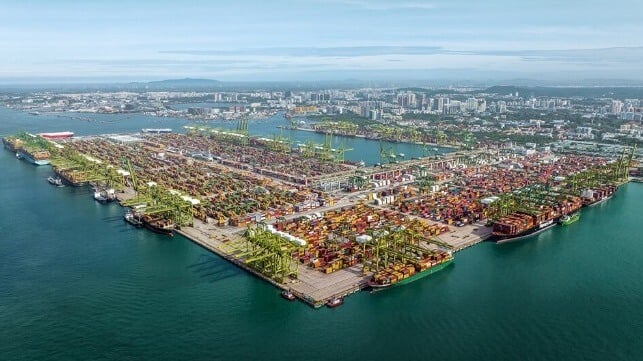Singapore Takes Steps to Address Containership Congestion

Singapore’s Ministry of Transport along with the Maritime and Port Authority of Singapore and terminal operator PSA are working to alleviate the congestion in container shipping. They outlined the steps being taken while confirming the reports earlier in the week of congestion and vessel bunching due to the impact of Red Sea diversions on carrier schedules.
Hong Kong-based market intelligence firm Linerlytica, warned this week that port congestion was mounting primarily in Asia with Singapore being among the hardest hit. They said as many as 450,000 TEU were in the queue in Singapore while reporting containerships were being forced to hold off, sometimes at distance anchorages, due to a lack of berth space. Linerlytica said the wait was up to seven days in some cases for a berth in Singapore.
The MPA highlighted that container volume is up 8.8 percent so far in 2024 amounting to 13.36 million TEUs in the first four months of the year. They said part of the reason for the strong increase was several container lines discharging more containers in Singapore as they forego some port stops to catch up on schedules. They said ships are also using Singapore’s facilities to manage container stowage to facilitate handling during subsequent port calls. The number of containers being handled per vessel has also increased.
“The increase in container vessels arriving off-schedule and the increased container volumes handled in Singapore has resulted in longer vessels’ wait time for a container berth,” the MPA confirmed. They said however along with PSA they are working with carriers to adjust arrival schedules when possible to reduce vessel bunching. They contend the average wait time for a berth is now two to three days while highlighting that it is only for containerships. Furthermore, they said about two-thirds of the vessel calls in Singapore are not impacted as tankers and bulkers are resupplied and bunkered in the anchorage.
They said efforts had begun in late 2023 anticipating the disruptions to schedules and increase in volumes. This included adding more staffing and container handling capacity to handle the anticipated volume surge. Among the specific steps taken included reactivating older berths and yards some of which were not used as the Keppel Terminal was being transitioned to the new Tuas mega terminal.
The Tuas Port currently has eight berths operating and three more will be added this year. PSA’s weekly container handling volume they said has grown from 770,000 to 820,000 TEU, a more than six percent increase while work is also being accelerated for the commissioning of the added berth.
These challenges are likely to persist well into 2024 as the carriers continue to divert from the Red Sea routes. The ships are struggling to keep up with demand while having to travel significant extra distances to reach Europe. Compounding the challenges for Singapore is the continuing introduction of ultra large container vessels (ULCVs) with 24,000 TEU capacity. Ocean Network Express (ONE) for example highlighted setting several new loading records each above 22,000 TEU and each record involved loading in Singapore. Tuas was developed to accommodate the anticipated growth in container volumes.
